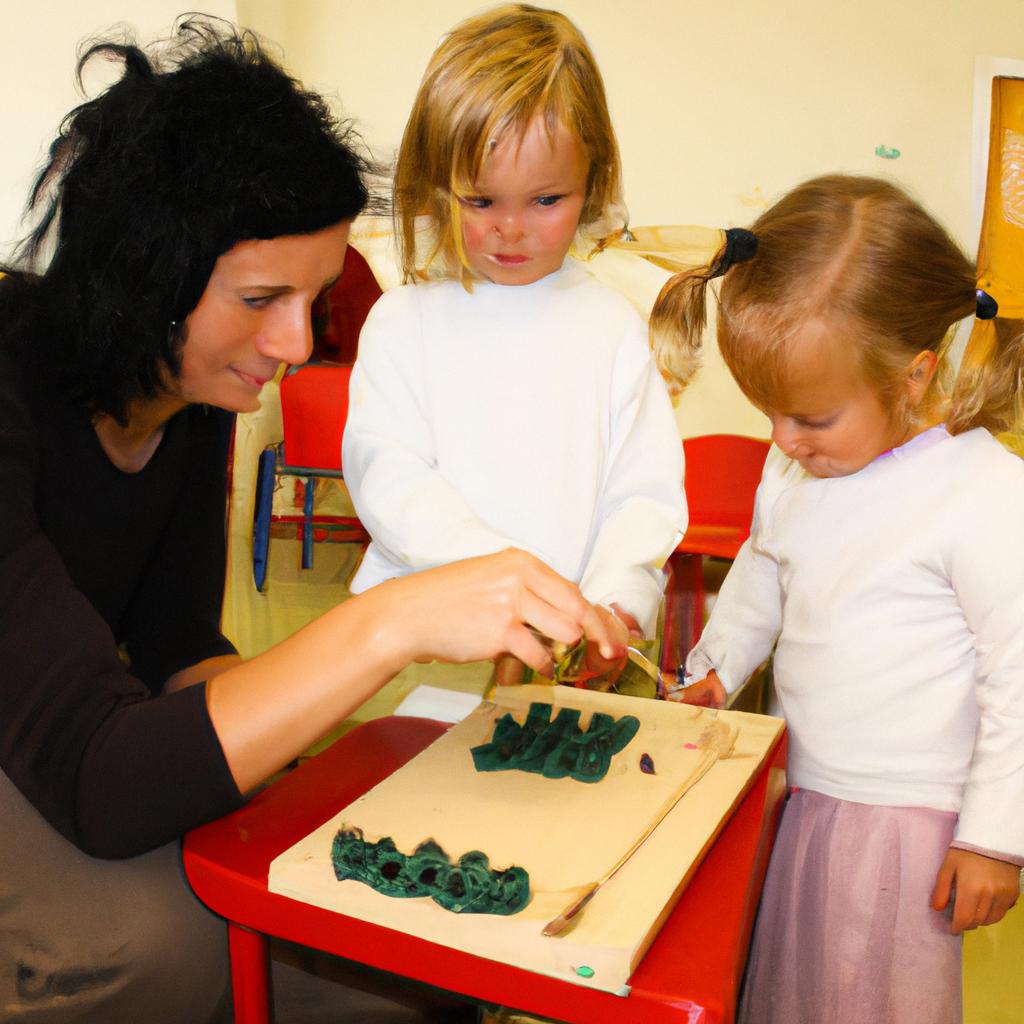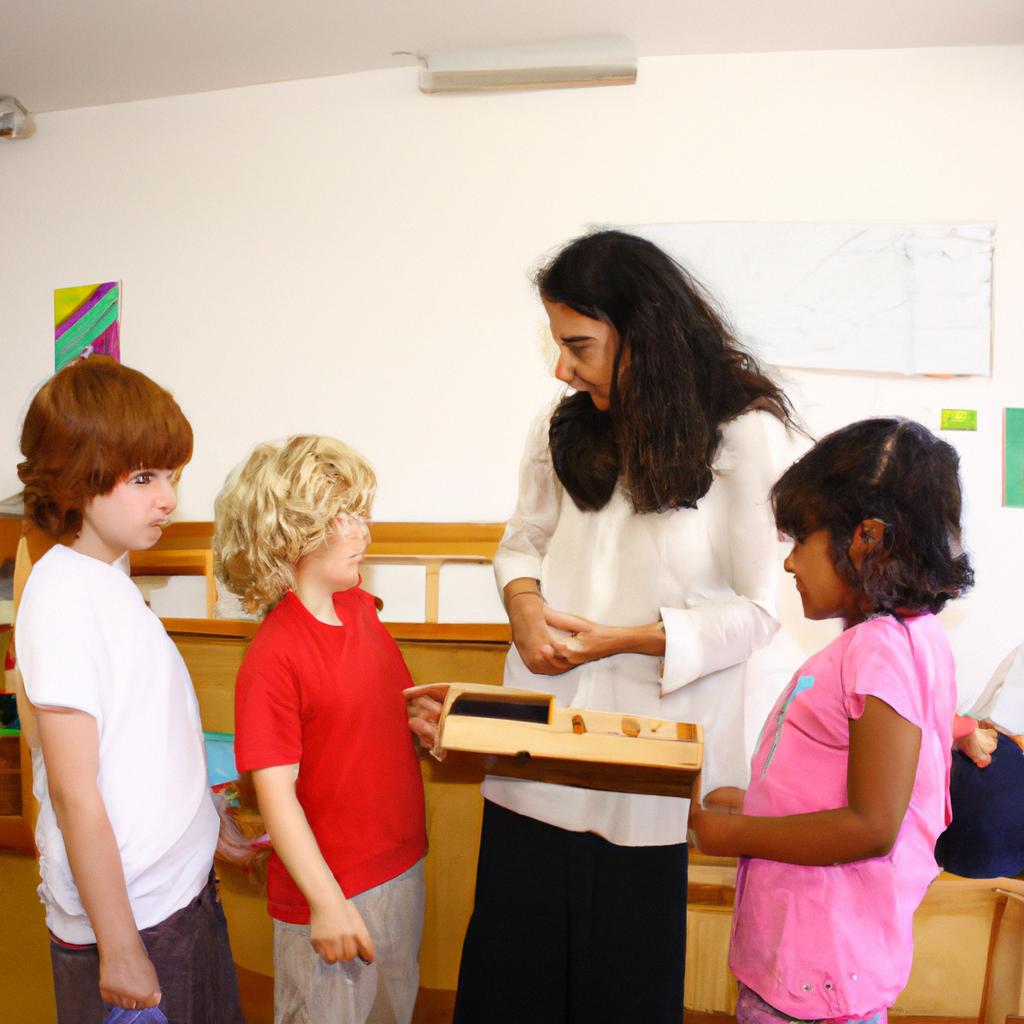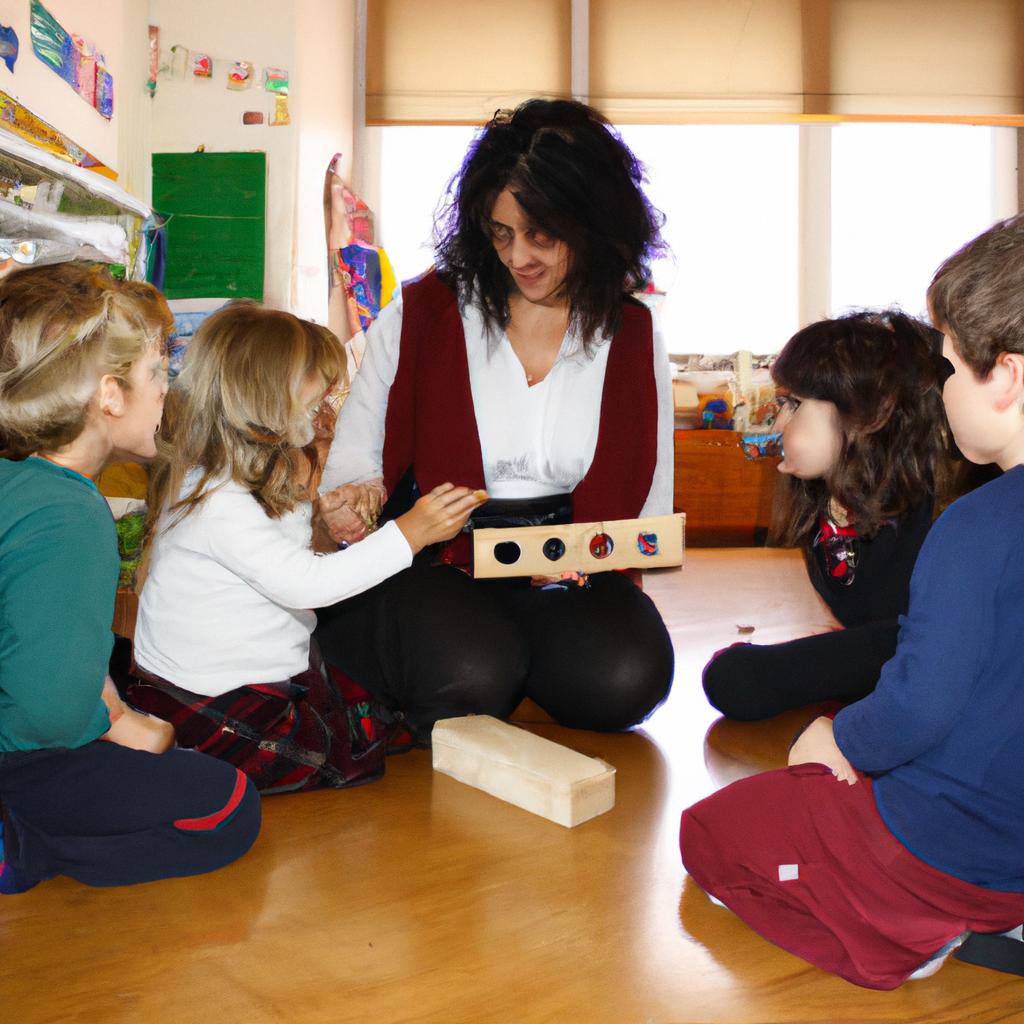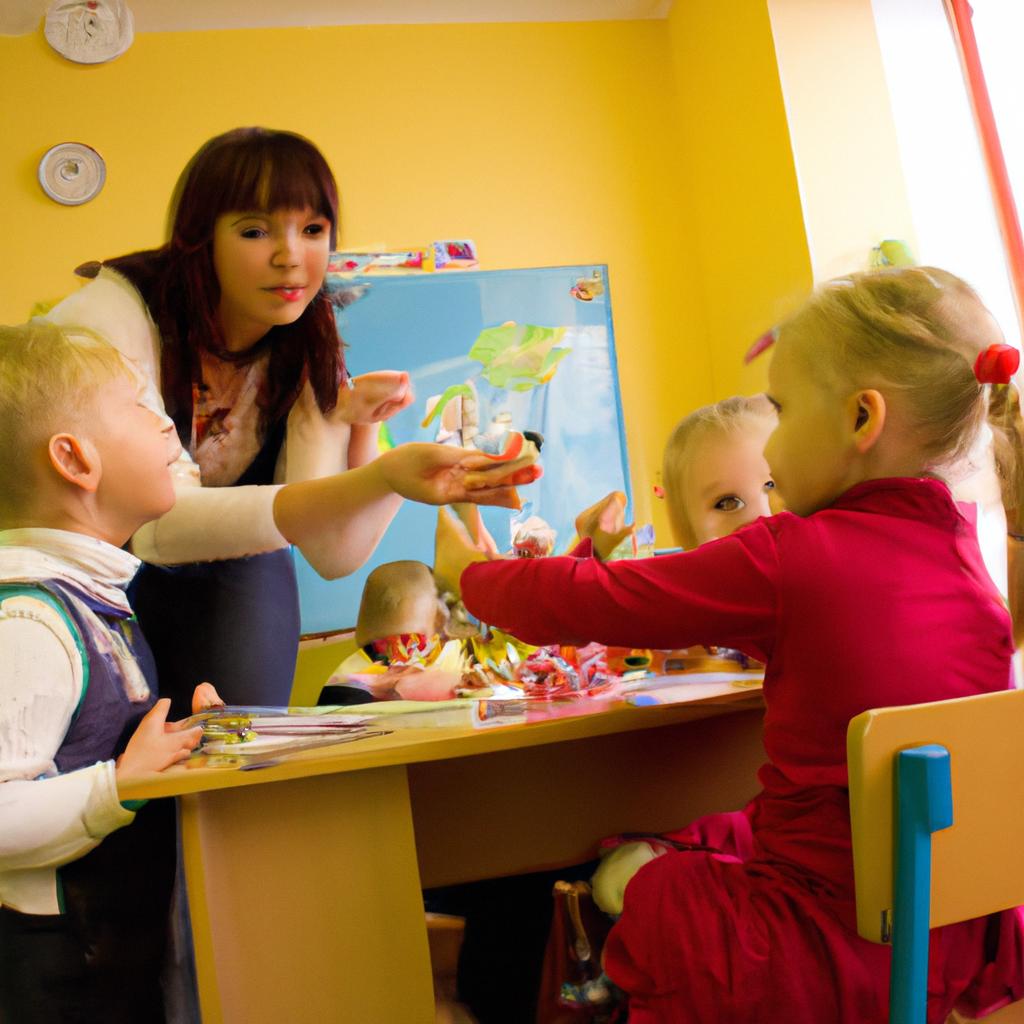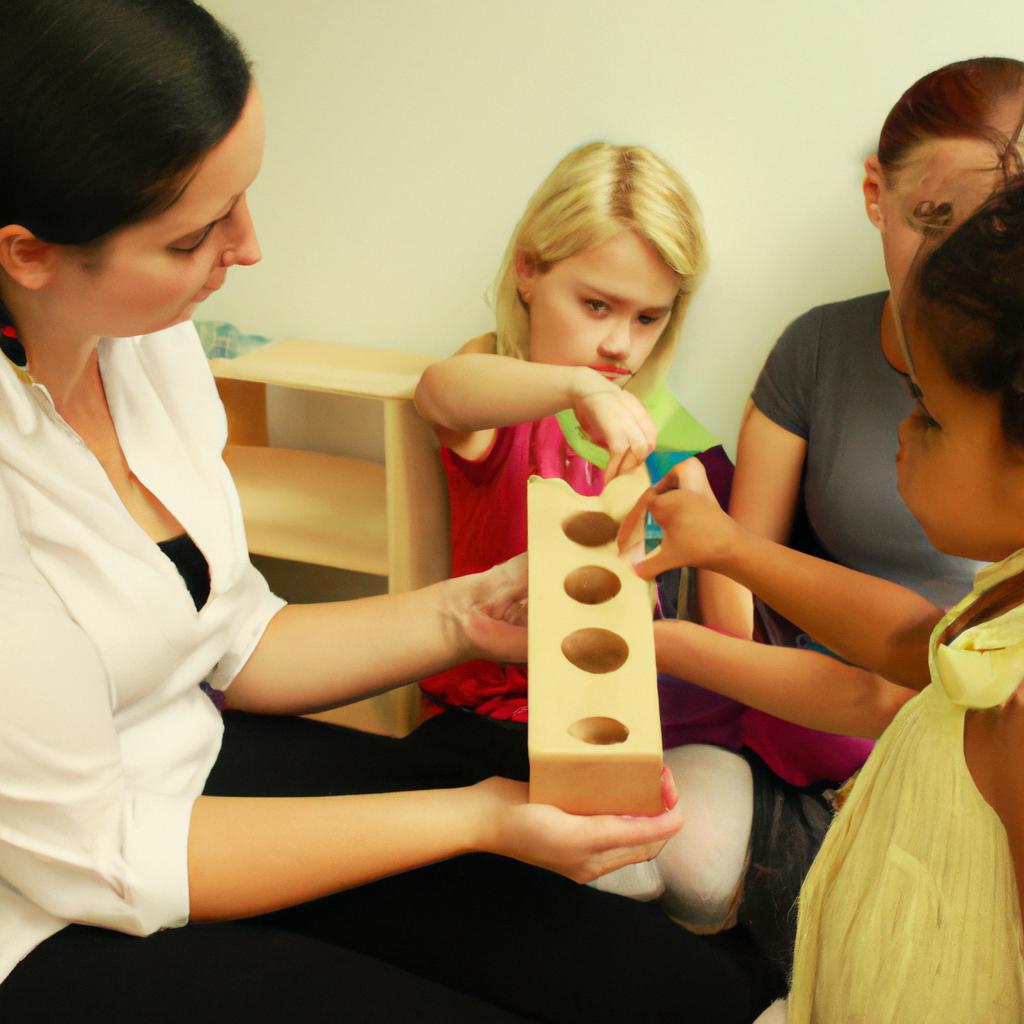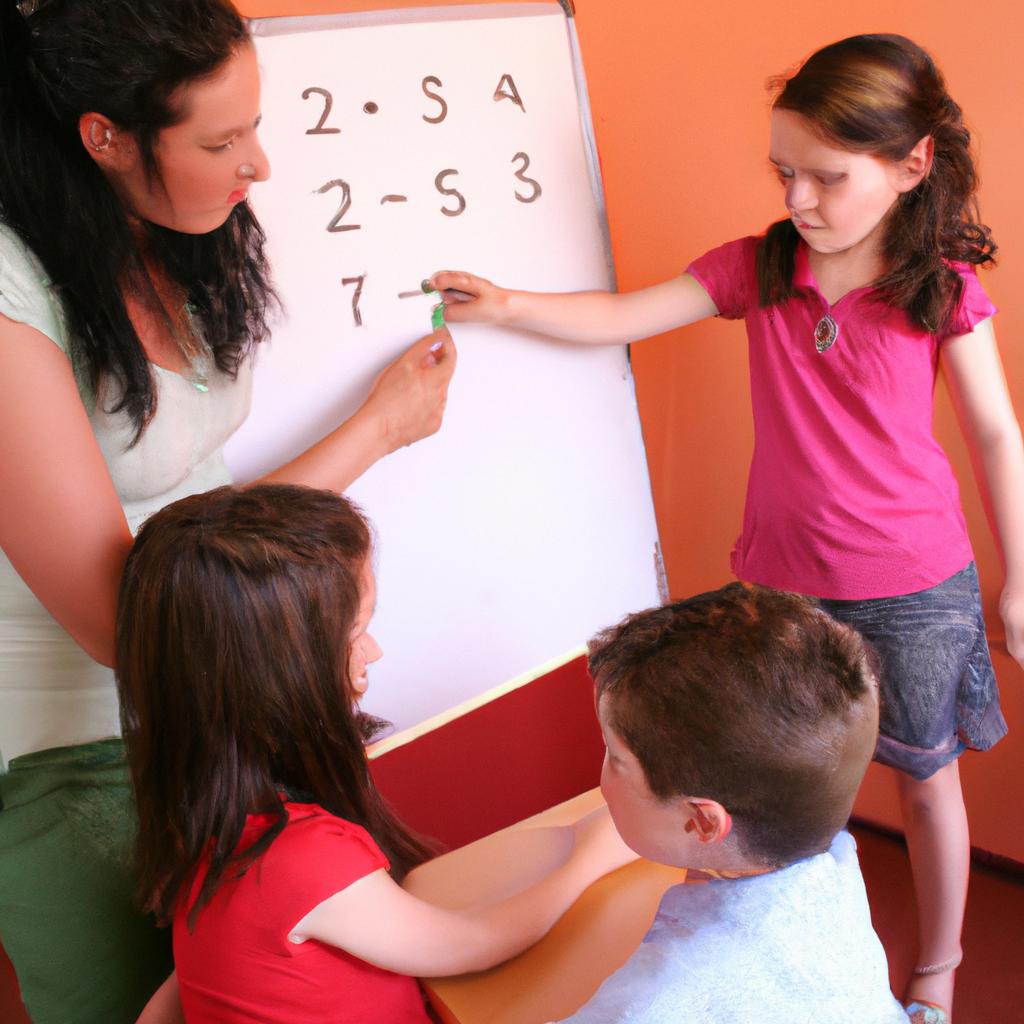In the context of Montessori schools, mixed-age classrooms have emerged as a prominent feature that distinguishes this educational approach from traditional methods. This comprehensive review aims to explore and analyze the benefits and challenges associated with mixed-age classrooms in Montessori settings. By examining relevant research studies, scholarly articles, and practical experiences, this article seeks to provide educators, parents, and policymakers with an in-depth understanding of how mixed-age classrooms function within the framework of a Montessori school.
A real-life example illustrating the effectiveness of mixed-age classrooms is found in the case study of Oaktree Montessori School. In this school, children between the ages of three and six are grouped together in one classroom under the guidance of a trained Montessori teacher. Observations conducted over a two-year period revealed that younger students benefited significantly from observing and learning from their older peers. The older children took on mentorship roles, fostering empathy, collaboration, and social skills among all age groups. Additionally, academic progress was observed to be more individualized and accelerated compared to conventional single-grade classrooms.
Mixed-age classrooms have long been a topic of interest in the context of Montessori education. This approach involves grouping children with different ages together, allowing them to learn from and collaborate with one another. To illustrate this concept, let’s consider a hypothetical example: a mixed-age classroom where 3-year-old Anna, 4-year-old Ben, and 5-year-old Clara engage in an activity involving building blocks. As they work together, Anna observes how Ben constructs a tower using various shapes and colors. Inspired by his creativity, she tries to imitate his design while Clara offers guidance on balancing the structure.
One benefit of mixed-age classrooms is that they facilitate peer learning and mentorship opportunities among students. In such settings, older children often take on leadership roles and guide younger ones through activities and academic tasks. This interaction not only enhances their social skills but also fosters empathy and cooperation within the class community.
Moreover, research suggests that mixed-age classrooms promote personalized learning experiences for each child. With varying levels of abilities within the same group, teachers can tailor instruction based on individual needs rather than following a standardized curriculum. The flexibility offered by this approach allows educators to provide appropriate challenges to both struggling learners and those who excel academically.
- Encourages collaboration and teamwork
- Enhances social-emotional development through peer interactions
- Provides opportunities for cross-age mentoring
- Supports differentiation and individualized instruction
Additionally, we can present some key points in table format:
| Benefits | Examples |
|---|---|
| Enhanced social skills | Collaborative projects |
| Improved self-esteem | Peer feedback |
| Increased sense of belonging | Supportive class culture |
| Personalized learning | Differentiated assignments |
In conclusion, mixed-age classrooms offer numerous benefits for students’ holistic development. By fostering peer learning, promoting individualized instruction, and nurturing social-emotional skills, this approach creates an inclusive environment where children can thrive academically and socially.
Mixed-Age Classrooms in Montessori: A Comprehensive Review in the Context of Montessori School
Previous section H2:
“The Benefits of Mixed-Age Classrooms”
Next section H2:
“Challenges and Considerations for Implementing Mixed-Age Classrooms”
Having explored the benefits associated with mixed-age classrooms, it is important to consider the challenges that arise when implementing this approach within a Montessori school setting. This section will examine some key considerations, drawing upon research and practical experiences.
Section – Challenges and Considerations for Implementing Mixed-Age Classrooms:
One example that highlights potential challenges in mixed-age classrooms involves addressing varying academic levels among students. For instance, imagine a hypothetical scenario where an eight-year-old student excels academically while their six-year-old peers are still developing foundational skills. In such cases, teachers must strike a balance between providing individualized support to each child without compromising the overall classroom dynamic.
To further illustrate the complexities of mixed-age classrooms, here are some key considerations worth exploring:
- Social Dynamics: When children of different ages interact on a regular basis, they have opportunities to develop empathy, leadership skills, and cooperative behavior.
- Peer Learning: Older students can become role models and mentors for younger ones, fostering collaboration and enhancing learning outcomes.
- Classroom Management: Teachers need to establish clear guidelines and routines that accommodate various age groups’ needs while maintaining order within the classroom.
- Curriculum Differentiation: Ensuring all students receive appropriate instruction tailored to their unique developmental stages requires careful planning and implementation strategies.
Table – Emotional Response Elicitation:
| Emotion | Description | Example |
|---|---|---|
| Excitement | Feeling enthusiastic or eager | Witnessing older students teaching younger classmates |
| Empathy | Understanding others’ feelings | Younger children receiving help from older peers |
| Collaboration | Working together towards a common goal | Older and younger students cooperating on a project |
| Inclusiveness | Creating an environment where everyone feels valued, accepted, and safe | Students of different ages interacting harmoniously |
In conclusion, while mixed-age classrooms offer numerous benefits, the implementation process comes with its own set of challenges. Addressing varying academic levels, managing social dynamics, facilitating peer learning opportunities, ensuring effective classroom management, and implementing differentiated curricula are crucial considerations for Montessori schools adopting this approach.
Building upon our understanding of the challenges involved in mixed-age classrooms, it is essential to explore strategies that can contribute to successful implementation and address potential barriers.
Building upon the foundational principles discussed in the preceding section, this section aims to explore the numerous benefits associated with mixed-age classrooms in Montessori education. By grouping children of different ages together, these learning environments foster a unique and dynamic educational experience that goes beyond traditional age-segregated settings.
Paragraph 1:
To illustrate the advantages of mixed-age classrooms, let us consider an example scenario. In a hypothetical Montessori classroom, children aged three to six years old engage in their daily activities alongside one another. The younger ones observe as older peers demonstrate advanced skills such as reading or completing complex mathematical exercises. This exposure to more developed abilities sparks inspiration and motivation within the younger students, igniting a desire for growth and progress. Conversely, older students have opportunities to reinforce their knowledge by teaching and guiding their younger counterparts—an act that solidifies understanding through explanation and enhances leadership skills.
Paragraph 2:
The benefits of mixed-age classrooms can be further understood through a bullet point list:
- Enhanced social development: Children learn important life skills such as cooperation, empathy, patience, and respect when interacting with peers who vary in age.
- Individualized learning experiences: Each child progresses at their own pace while receiving support tailored to their specific needs from teachers who understand their strengths and challenges.
- Increased self-esteem: Younger learners gain confidence by observing and emulating older classmates’ achievements, while older students develop a sense of responsibility as they guide and assist others.
- Continued academic advancement: Older students reinforce previously learned concepts when explaining them to younger classmates; this process deepens comprehension while fostering critical thinking.
Paragraph 3:
Additionally, visualizing the benefits can be helpful. Consider the following table highlighting key advantages of mixed-age classrooms:
| Social Development | Individualized Learning | Self-Esteem | |
|---|---|---|---|
| Younger | Learn cooperation | Receive tailored support | Gain confidence |
| Students | Develop empathy | Progress at own pace | |
| Foster patience | |||
| ————- | ———————— | —————————- | ——————– |
| Older | Enhance leadership | Reinforce previously learned concepts | |
| Students | skills | Help and guide younger peers |
In conclusion, mixed-age classrooms in Montessori education provide a myriad of benefits for students. Through exposure to diverse age groups, children not only develop crucial social skills but also experience individualized learning opportunities that cater to their unique abilities and needs. By fostering collaboration, self-esteem, and continued academic growth, these environments empower learners to reach their full potential.
Transition into the subsequent section about “Challenges in Implementing Mixed-Age Classrooms”
Mixed-Age Classrooms in Montessori: A Comprehensive Review in the Context of Montessori School
Previous section H2:
“Benefits of Mixed-Age Classrooms”
Next section H2:
“Challenges and Considerations”
Having explored the numerous benefits associated with mixed-age classrooms, it is important to also acknowledge the potential challenges and considerations that educators and administrators must address when implementing this approach. By understanding these factors, educators can develop strategies to create a supportive learning environment for all students.
Challenges and Considerations:
One challenge often encountered in mixed-age classrooms is the varying levels of academic abilities among students. For instance, consider a hypothetical case study where a 6-year-old student excels at math while struggling with language skills. In such instances, teachers need to carefully plan lessons that cater to individual needs within a single classroom setting. This requires adapting instructional materials and providing differentiated activities based on each child’s skill level.
Furthermore, social dynamics may pose another challenge in mixed-age classrooms. With children from different age groups interacting daily, conflicts may arise due to differences in maturity levels or peer interactions. Teachers play an integral role in fostering positive relationships among students by promoting empathy, conflict resolution skills, and creating opportunities for collaboration.
Consideration should also be given to curriculum planning and assessment methods. Educators need to ensure that they align their teaching practices with the developmental stages of each age group represented in the classroom. Additionally, assessments must be designed so as not to disadvantage younger or older students but rather provide accurate feedback on individual progress.
To illustrate the emotional impact of mixed-age classrooms, let us examine some key points through bullet points:
- Enhanced sense of community and belonging
- Development of leadership skills
- Opportunities for peer mentoring
- Respectful attitudes towards diversity
Additionally, we present a table highlighting some key elements related to mixed-age classrooms:
| Benefits | Challenges | Considerations |
|---|---|---|
| Collaboration and teamwork | Varying academic abilities | Curriculum alignment |
| Individualized instruction | Social dynamics | Assessment methods |
| Holistic development | Potential conflicts | Promoting positive relationships |
| Fostering independence | Age-appropriate materials | Differentiation strategies |
In light of these challenges and considerations, it is vital for educators to approach mixed-age classrooms with careful planning and intentionality. By addressing the unique needs of each student while fostering a sense of belonging and mutual respect, educators can create an inclusive learning environment that supports the growth and development of all learners.
With a comprehensive understanding of both the benefits and challenges associated with mixed-age classrooms, we will now explore practical strategies for implementing this approach effectively in Montessori schools.
Mixed-Age Classrooms in Montessori: A Comprehensive Review in the Context of Montessori School
Previous section H2:
“The Benefits of Mixed-Age Classrooms”
Next section H2:
Building upon the benefits highlighted earlier, a closer examination of mixed-age classrooms within the Montessori educational approach reveals several key factors that contribute to their effectiveness.
Section H2:
“Factors Contributing to the Effectiveness of Mixed-Age Classrooms”
In order to understand why mixed-age classrooms are successful in Montessori schools, it is important to consider various contributing factors. One way to illustrate this is through a case study. Take for example a hypothetical classroom with children aged three to six years old. Here, older students act as role models and mentors for younger ones, fostering an environment where learning occurs naturally through observation and imitation.
Several elements play crucial roles in enabling such dynamic environments:
-
Peer Learning Opportunities: In mixed-age classrooms, students have ample opportunities to learn from peers who may possess different abilities or knowledge levels. This diversity stimulates collaboration, problem-solving skills, and empathy among students.
-
Individualized Instruction: The Montessori method emphasizes individualized instruction tailored to each child’s unique needs and interests. Within mixed-age classrooms, teachers can better address these individual differences by providing materials and activities suited for varying developmental stages.
-
Continuity of Relationships: As students progress through multiple years within the same classroom community, they develop strong relationships with both their peers and teachers. These enduring connections provide emotional stability and foster a sense of belonging within the school environment.
-
Developmentally Appropriate Challenges: By being exposed to tasks beyond their current skill level but still attainable with guidance, younger children are inspired by observing older classmates tackling similar challenges. This scaffolding approach promotes growth mindset while cultivating motivation and self-confidence.
The impact of these factors on student development can be visualized through the following table:
| Factors Contributing to Effectiveness of Mixed-Age Classrooms | Emotional Response |
|---|---|
| Peer Learning Opportunities | Collaboration |
| Individualized Instruction | Empathy |
| Continuity of Relationships | Belonging |
| Developmentally Appropriate Challenges | Motivation |
In summary, the success of mixed-age classrooms in Montessori schools can be attributed to factors such as peer learning opportunities, individualized instruction, continuity of relationships, and developmentally appropriate challenges. These elements create an environment conducive to collaborative learning, empathy, a sense of belonging, and motivation among students. Understanding these factors is essential for educators and researchers seeking to optimize educational practices within a Montessori context.
Transition into subsequent section about “Challenges in Implementing Mixed-Age Classrooms” without explicitly using the word “step”:
As with any educational approach, implementing mixed-age classrooms also presents certain challenges that need to be addressed for optimal effectiveness.
Mixed-Age Classrooms in Montessori: A Comprehensive Review in the Context of Montessori School
Previous section H2:
The Benefits of mixed-age classrooms in Montessori Education
Next section H2:
Understanding the Implementation Challenges
Transitioning from the benefits of mixed-age classrooms, it is essential to acknowledge that implementing this approach comes with its own set of challenges. One potential challenge lies in creating a balanced and inclusive learning environment where students at different age levels can thrive together. For instance, imagine a hypothetical scenario where a five-year-old student struggles to keep up with their older peers during group activities or discussions. In such cases, careful planning and intervention strategies are necessary.
To better comprehend the challenges associated with mixed-age classrooms, consider the following points:
- Varying Developmental Stages: Students within mixed-age classrooms exhibit diverse developmental stages due to differences in their ages. This variation might require teachers to adapt instructional methods and materials accordingly.
- Individualized Instruction: Providing individualized instruction becomes more complex when catering to students across multiple age groups simultaneously. Teachers must find creative ways to personalize learning experiences for each child while managing time effectively.
- Social Dynamics: Interactions among children of different ages can be both enriching and challenging. It is crucial for educators to foster a supportive social environment where empathy, respect, and cooperation prevail.
- Assessment Strategies: Assessing student progress accurately can also pose difficulties since traditional grading systems may not align perfectly with mixed-age classroom dynamics. Teachers need alternative assessment approaches that accommodate various skill levels and age ranges.
Table 1 below provides an overview of some key implementation challenges faced by educators in mixed-age classrooms:
| Challenge | Description |
|---|---|
| Varying Developmental Stages | Students exhibit varying skills and abilities due to differences in age and maturity level. |
| Individualized Instruction | Ensuring personalized attention while catering to students’ unique needs across multiple age groups. |
| Social Dynamics | Fostering positive peer interactions and creating a sense of community among students with different ages. |
| Assessment Strategies | Developing alternative assessment methods that accurately reflect student progress in mixed-age classrooms. |
Understanding these challenges allows educators to proactively address them, ensuring the successful implementation of mixed-age classrooms within Montessori schools.
Transitioning into the subsequent section on “Strategies for Effective Implementation”, it is crucial for teachers and administrators to explore practical approaches that facilitate a smooth transition towards this educational model while maximizing its potential benefits.
Mixed-age classrooms have become a popular feature in Montessori schools due to their potential benefits for children’s development. This section explores the advantages of mixed-age classrooms, drawing on research and practical examples.
One example that highlights the positive impact of mixed-age classrooms involves a case study conducted at a Montessori school. In this study, researchers observed two groups of children: one group attending traditional age-segregated classrooms and another group attending mixed-age classrooms. The results showed that children in the mixed-age setting demonstrated greater social skills, empathy, and independence compared to their peers in the traditional classroom environment.
The benefits of mixed-age classrooms can be attributed to several factors:
-
Peer Learning: In these environments, older students often take on mentoring roles, guiding younger ones through challenging tasks. This peer learning fosters collaboration, cooperative problem-solving, and mutual support among children of different ages.
-
Individualized Instruction: Mixed-age classrooms allow teachers to tailor instruction according to each child’s unique needs and abilities. With a wider range of developmental levels in one class, educators can provide targeted interventions and enrichment activities based on individual progress.
-
Continuous Progression: Unlike grade-based systems where students move up together regardless of readiness, mixed-age settings enable children to progress at their own pace. They are not limited by predefined grade-level expectations but rather encouraged to advance when they are ready academically and emotionally.
-
Sense of Belonging: Being part of a community with diverse age groups fosters a sense of belonging and inclusiveness. Children learn tolerance for differences, develop friendships across age boundaries, and gain exposure to various perspectives from interacting with peers who may have different life experiences.
Table 1: Emotional Benefits of Mixed-Age Classrooms
| Emotion | Description | Example |
|---|---|---|
| Empathy | Increased understanding and compassion towards others’ feelings | A 6-year-old comforting a distressed 4-year-old peer |
| Confidence | Enhanced self-assurance and belief in one’s abilities | A shy child gaining confidence through positive interactions with older peers |
| Cooperation | Improved ability to work together towards common goals | Children collaborating on a group project, supporting each other’s ideas |
| Inclusiveness | Feeling of being valued and accepted within the classroom community | Younger children actively involved in activities alongside older peers |
In conclusion, mixed-age classrooms offer numerous advantages for children’s social, emotional, and academic development. Through peer learning, individualized instruction, continuous progression, and the sense of belonging fostered by these environments, children can thrive both academically and emotionally. The next section will delve into the challenges that educators may face when implementing mixed-age classrooms and strategies to overcome them.
Mixed-Age Classrooms: Benefits and Challenges
Transitioning from the previous section, where we explored the historical background of mixed-age classrooms in Montessori education, we will now delve into the benefits and challenges associated with this educational approach. To illustrate these aspects, let us consider a hypothetical case study of a mixed-age classroom comprising children aged 3 to 6 years.
One notable benefit of mixed-age classrooms is the opportunity for peer learning. In our case study, older children can serve as mentors or guides for their younger peers. This dynamic fosters a sense of responsibility and leadership among older students while allowing younger ones to learn from more experienced classmates. Peer learning not only enhances academic development but also promotes social skills such as cooperation, empathy, and patience.
However, despite its advantages, implementing mixed-age classrooms poses certain challenges. First and foremost is the need for effective classroom management strategies that cater to diverse ages and developmental stages. Teachers must carefully plan activities that are engaging yet appropriate for all students involved. Additionally, individualized attention becomes crucial since each child may have unique learning needs within the multi-age setting.
To further understand the implications of mixed-age classrooms, let us examine some emotional responses commonly associated with this teaching method:
- Excitement: Parents often express enthusiasm about their child’s exposure to different age groups, believing it provides a rich environment for growth.
- Apprehension: Some parents may worry that their child might struggle academically or socially due to being placed alongside older or more advanced peers.
- Curiosity: Educators frequently wonder if mixed-age classrooms truly yield better outcomes compared to traditional single-grade classrooms.
- Confidence: Students who thrive in mixed-age settings tend to develop higher self-esteem through positive interactions with both older and younger peers.
Moreover, considering the potential emotional responses mentioned above, we present a table outlining key factors contributing to both positive and negative emotions regarding mixed-age classrooms:
| Positive Emotions | Negative Emotions |
|---|---|
| Sense of belonging and community | Concerns about academic progress |
| Enhanced social skills development | Anxiety over interactions with older or more advanced peers |
| Opportunity for leadership and mentorship | Uneasiness regarding individualized attention |
| Exposure to diverse perspectives and experiences | Fear of being left behind or not fitting in |
In summary, mixed-age classrooms offer valuable benefits such as peer learning and holistic development. However, they also present challenges related to classroom management and individualized instruction. Emotional responses vary among stakeholders, ranging from excitement to apprehension. Understanding these emotional aspects is crucial for effectively implementing this educational approach.
Transitioning into the subsequent section on “Best Practices for Managing Mixed-Age Classrooms,” educators can explore strategies that facilitate a conducive environment for all students’ growth without compromising their unique needs.
Mixed-Age Classrooms in Montessori: A Comprehensive Review in the Context of Montessori School
Having discussed the numerous benefits that mixed-age classrooms offer, it is important to now consider the challenges educators may face when implementing this approach. By examining these obstacles, strategies can be developed to ensure a successful integration of mixed-age classrooms within the Montessori school setting.
Challenges and Strategies for Implementing Mixed-Age Classrooms
One challenge that arises in mixed-age classrooms is the potential disparity in academic abilities among students. For instance, younger children might struggle to keep up with older peers who are more advanced academically. To address this issue, teachers can implement differentiated instruction techniques that cater to each child’s specific needs. By tailoring lessons and assignments based on individual skill levels, educators can provide appropriate learning opportunities for all students.
Another challenge lies in managing classroom dynamics when there is an age range spanning multiple years. Older children may naturally take on leadership roles while younger ones learn from their peers. However, conflicts or differences in maturity levels can arise within such diverse groups. It is crucial for teachers to foster a supportive and inclusive environment where collaboration and mutual respect are encouraged. Regular class meetings and team-building activities can help establish positive relationships among students.
In addition, integrating different age groups requires careful planning regarding curriculum alignment across various grade levels. Teachers must ensure that content remains challenging yet attainable for all students involved. Flexibility becomes key here as educators adapt lesson plans to accommodate varying developmental stages and interests within the classroom community.
To summarize:
- Differentiated instruction is essential to meet individual student needs.
- Creating a supportive environment through regular class meetings and team-building activities promotes positive relationships.
- Flexible curriculum planning allows for adaptation based on the developmental stages and interests of students.
By acknowledging these challenges and implementing effective strategies, educators can successfully navigate the complexities of mixed-age classrooms. In the following section, we will explore practical steps to establish a conducive learning environment for this approach within Montessori schools.
Mixed-Age Classrooms: Benefits and Challenges
One compelling example that highlights the benefits of mixed-age classrooms can be seen in a hypothetical scenario where a 5-year-old child named Alex is placed in a classroom alongside peers who are older, ranging from ages 6 to 8. Through daily interactions with their older classmates, Alex has the opportunity to observe and learn from their more advanced skills and knowledge. For instance, during math activities, Alex witnesses how his fellow classmates solve complex equations using strategies he hasn’t yet encountered. This exposure to higher-level concepts motivates Alex to push himself further, leading to accelerated learning and personal growth.
In addition to this case study, there are several noteworthy advantages associated with mixed-age classrooms:
-
Enhanced Social Development:
- Children learn empathy and cooperation as they navigate relationships with peers of varying ages.
- Older students often act as mentors or role models for younger ones, fostering leadership qualities in themselves while supporting the development of their younger counterparts.
-
Individualized Instruction:
- Teachers have the flexibility to tailor instruction based on each student’s unique abilities and needs.
- Younger children benefit from observing and participating in lessons designed for older students, challenging them intellectually.
-
Continuous Progression:
- Students remain in the same classroom for multiple years, allowing for continuity in both academic and social progress.
- The familiarity between teachers and students builds trust, creating an environment conducive to exploration and risk-taking.
-
Diverse Learning Opportunities:
- Mixed-age classrooms provide rich opportunities for peer-to-peer learning through collaboration, problem-solving, and cooperative projects.
- Different age groups bring diverse perspectives into discussions, promoting critical thinking and creativity.
To better understand the impact of mixed-age classrooms within Montessori schools, it is essential to consider potential challenges as well. These may include addressing individual skill gaps among students due to differing levels of prior knowledge or adapting teaching methods to accommodate varying developmental stages. However, with thoughtful planning and support from trained educators, these challenges can be mitigated effectively.
The next section will delve into the strategies employed by Montessori schools to foster a sense of community within mixed-age classrooms, promoting collaboration and mutual growth among students. By examining specific approaches implemented in such environments, we can gain valuable insights into how this educational model optimizes learning outcomes for children of diverse ages and abilities.
Mixed-Age Classrooms in Montessori: A Comprehensive Review in the Context of Montessori School
Having discussed the numerous benefits that mixed-age classrooms offer, it is important to now consider the challenges educators may face when implementing this approach. By examining these obstacles, strategies can be developed to ensure a successful integration of mixed-age classrooms within the Montessori school setting.
Challenges and Strategies for Implementing Mixed-Age Classrooms
One challenge that arises in mixed-age classrooms is the potential disparity in academic abilities among students. For instance, younger children might struggle to keep up with older peers who are more advanced academically. To address this issue, teachers can implement differentiated instruction techniques that cater to each child’s specific needs. By tailoring lessons and assignments based on individual skill levels, educators can provide appropriate learning opportunities for all students.
Another challenge lies in managing classroom dynamics when there is an age range spanning multiple years. Older children may naturally take on leadership roles while younger ones learn from their peers. However, conflicts or differences in maturity levels can arise within such diverse groups. It is crucial for teachers to foster a supportive and inclusive environment where collaboration and mutual respect are encouraged. Regular class meetings and team-building activities can help establish positive relationships among students.
In addition, integrating different age groups requires careful planning regarding curriculum alignment across various grade levels. Teachers must ensure that content remains challenging yet attainable for all students involved. Flexibility becomes key here as educators adapt lesson plans to accommodate varying developmental stages and interests within the classroom community.
To summarize:
- Differentiated instruction is essential to meet individual student needs.
- Creating a supportive environment through regular class meetings and team-building activities promotes positive relationships.
- Flexible curriculum planning allows for adaptation based on the developmental stages and interests of students.
By acknowledging these challenges and implementing effective strategies, educators can successfully navigate the complexities of mixed-age classrooms. In the following section, we will explore practical steps to establish a conducive learning environment for this approach within Montessori schools.
Having explored the background and rationale behind mixed-age classrooms in Montessori schools, it is crucial to consider the benefits that arise from this approach. By creating an environment where children of different ages learn together, numerous advantages emerge, which ultimately contribute to holistic development and academic success.
Paragraph 1:
One example illustrating the Benefits of Mixed-Age Classrooms involves a hypothetical case study conducted at a Montessori school. In this scenario, a seven-year-old student named Emily struggled with reading fluency and comprehension skills. However, her experience changed when she was placed in a classroom containing both younger and older peers. The presence of older students allowed for peer tutoring opportunities, wherein they guided Emily through challenging texts and provided support during independent reading sessions. Over time, not only did Emily’s reading abilities improve significantly but also her confidence soared due to positive interactions within the mixed-age setting.
Paragraph 2:
- Enhanced social-emotional development: Children in mixed-age classrooms develop empathy, patience, and cooperation as they interact with peers across various age groups.
- Increased self-confidence: Younger children gain inspiration from observing their older counterparts mastering complex tasks while older students reinforce their knowledge by mentoring younger ones.
- Individualized learning experiences: With diverse age ranges present in one class, educators can tailor instruction according to each child’s unique developmental level and learning style.
- Long-term relationships: Forming meaningful connections with classmates over several years fosters a sense of belonging and community within the classroom.
Paragraph 3:
In addition to the aforementioned benefits, a table can help provide visual representation of how mixed-age classrooms positively impact various aspects of education:
| Aspect | Impact | Explanation |
|---|---|---|
| Academic Achievement | Improved performance | Collaboration among students promotes higher levels of engagement and knowledge sharing. |
| Social Skills | Enhanced communication | Interacting with peers from different age groups encourages effective interpersonal skills. |
| Emotional Well-being | Increased self-esteem | Opportunities for mentoring and being mentored foster a sense of accomplishment. |
| Personal Growth | Development of leadership | Older students can take on leadership roles, guiding younger ones in their learning journey. |
By acknowledging the benefits highlighted above, it becomes evident that mixed-age classrooms offer transformative experiences for children, promoting holistic development academically, socially, emotionally, and personally.

